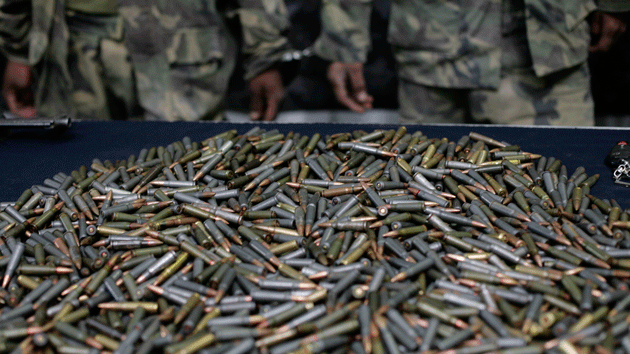
Ammunition sits on a table in front of alleged members of a drug cartel in Guadalajara, Mexico.Carlos Jasso/AP
The same routes that Mexico’s drug cartels use to smuggle drugs into the United States are also used to run American guns into Mexico, according to a new report from the Government Accountability Office (GAO).
The report, commissioned by Rep. Eliot Engel (D-N.Y.) and published yesterday, reveals that 70 percent—more than 73,000—of the guns recovered from crime scenes in Mexico and traced by the Bureau of Alcohol, Tobacco, Firearms and Explosives (ATF) from 2009 to 2014 originated in the United States. These weapons have fueled the ongoing war among the drug cartels and between the cartels and Mexican security forces, contributing to the more than 100,000 killings in the country since 2007.
The cartels’ weapons of choice are high-caliber rifles*, as well as AR-15 and AK-47-type semiautomatic rifles, which can be easily converted into fully automatic machine guns. The cartel’s gunrunners often buy firearms legally in the United States, either at gun shops, gun shows, or in private sales. The firearms are then illegally shipped across the border.
But increasingly, the cartels are shipping weapons parts into Mexico to be assembled into finished firearms. It’s a discreet process that is especially difficult to detect. Firearm manufacturers or importers in the United States are not required to stamp serial numbers on gun parts. Retailers do not have to report when they buy and sell parts kits with everything needed to complete a gun except a receiver. Receivers, which house the mechanical components of a firearm, like trigger groups and magazine feeds, can be purchased separately. To avoid detection, gunrunners will often use unfinished, or “80-percent” receivers—receivers that are mostly complete but require some further machining to be functional.
As I previously reported when I attended a gun building party in California, unfinished receivers are not classified as firearms. They don’t require serial numbers and generally have no markings, which makes firearms assembled with them untraceable. “They are also easy to conceal,” the GAO report noes, “making it more challenging for customs authorities to detect illicit shipments of such parts.” As Rep. Engel noted in a statement, the ATF has discretion over how it defines a receiver. Yet, as Engel puts it, “far too often, unfinished gun receivers are minimally modified to avoid regulation.”
The ATF has long been hindered by a lack of funds and agents, a problem that President Obama addressed in the executive action he announced last week that includes adding 200 new ATF agents and investigators. Engel said Congress could do more to “stop the illegal flow of guns across the U.S.-Mexico border” but accused his Republican colleagues of being “much more concerned with loosening already lax gun regulations than protecting citizens in both of our countries from gun violence.”
The GAO report also notes that collaboration between American and Mexican authorities is fraught. In 2012, joint US-Mexico efforts to stem firearms trafficking were scaled down when Mexican President Enrique Peña Nieto sharply limited law enforcement collaboration. In the past year, US officials reported to the GAO that collaboration is gaining momentum, but concerns over corruption among Mexican officials is still a problem. The report notes that Immigration and Customs Enforcement officials in the United States “are concerned about sharing information with ICE officials based in Mexico, fearing that the information may unintentionally reach corrupt Mexican authorities and compromise their investigations.”
Correction: This article previously misclassified the caliber of AK-47 and AR-15-type rifles.












